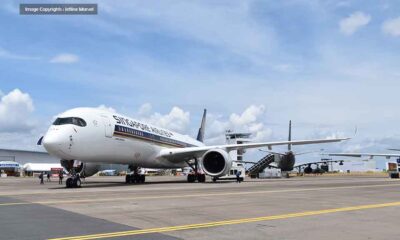Aviation
10 new planes you may fly soon in 2018 – 19

10 new planes you may fly soon in 2018 – 19
The Upcoming year would be filled with more Excitement because Aviation Fans may gone get to see and experience new aircraft in Airport. There are various manufacturers who are building advanced passenger aircraft which is likely to introduce in the Airliner Family very soon and some are very new to this segments like Chinese first Comac C919 and Russian First MC 21. But the competition is already built by Airbus and Boeing. In future Airliner Companies will have more option to choose various types and version aircraft for their Passengers Transport services. It also causes to the huge market changes for the respective country. Lets have glimpse of Aircraft which likely to introduce in upcoming year.
Comac C919 – China
It is a short-medium range commercial trunk liner that can claim indigenous intellectual property. Its all-economy class layout entails 168 seats, and the hybrid class layout 156 seats. The basic version is designed to cover a range of 4,075 km, while the enhanced version can stretch to 5,555 km. The C919 is designed to compete with the Airbus 320 and the Boeing 737, single-aisle planes that are the workhorses of the world’s airlines. For Comac, the plane represents the culmination of decades of work; for Airbus and Boeing, it is a challenge to a profitable duopoly that has endured for decades.
It rolled out on 2 November 2015 and first flew on 5 May 2017, for a planned introduction in 2020.
Mitsubishi Regional Jet – Japan
The Mitsubishi Regional Jet or MRJ for short, is a twin-engine regional jet aircraft seating 70–90 passengers manufactured by Mitsubishi Aircraft Corporation, a partnership between majority owner Mitsubishi Heavy Industries and Toyota Motor Corporation with design assistance from Toyota affiliate Fuji Heavy Industries, already a manufacturer of aircraft. It will be the first airliner designed and produced in Japan since the NAMC of the 1960s, which was produced at a loss. Its first flight was in November 2015.After a fifth delay, deliveries are scheduled to start by mid-2020.
MC 21 – Russia
The first MC-21-300 rolled-out on June 8, 2016 and first flew on May 28, 2017. It has a carbon fiber reinforced polymer wing and is powered by Pratt & Whitney PW1000G or Aviadvigatel PD-14 turbofans. With a capacity of 132-163 passengers in two class, up to 165-211 and up to 6,000–6,400 km (3,200–3,500 nmi) range, the standard MC-21-300 will be followed by a shortened MC-21-200. It has 175 orders as of June 2016.The initial design started in 2006 and detailed design was ongoing in 2011, after delaying introduction from 2012 to 2020
Boeing – United States
Boeing 737 Max – 9
First flight is the latest step in the airplane’s thorough flight-test program, which will be followed by first delivery in 2018. On first flight, teams performed tests on flight controls, systems and handling qualities. The 737 MAX 9 will now undergo comprehensive flight testing before customer deliveries start in 2018.The 737 MAX 9 debuted to the world on March 7. Since then, teams have been performing systems checks, fueling and engine runs on the flight line in preparation for first flight.
Boeing 737 Max – 10
The 737 MAX 10 will be the airlines’ most profitable single-aisle airplane, offering the lowest seat costs ever. Like Boeing’s other 737 MAX models, the MAX 10 incorporates the latest technology CFM International LEAP-1B engines, Advanced Technology winglets, Boeing Sky Interior, large flight deck displays, and other improvements to deliver the highest efficiency, reliability and passenger comfort in the single-aisle market.
Wide market acceptance with 361 orders, commitments from 16 customers. The 737 MAX is the fastest-selling airplane in Boeing history. The first MAX variant, the 737 MAX 8 has entered commercial service and will followed by the MAX 9, MAX 7 and the MAX 10, which will be introduced in the 2020 time frame.
Boeing 787 -Dreamliner 10
The 787-10 Dreamliner is the newest and longest member of the super-efficient 787 family. As a stretch of the 787-9, the 787-10 leverages the family’s proven technology, long range and preferred passenger experience, with unprecedented efficiency: 10 percent better fuel and emissions than the best on offer by the competition and 25 percent better than the airplanes it will replace.
The first test aircraft is engaged in flight envelope expansion work and the second joined the program in early May 2017, while the third with a passenger cabin interior to test the uprated environmental control system and Trent fuel-burn performance should join in June. The −10 will appear at the 2017 Paris Air Show and it will be first delivered to launch customer Singapore Airlines early in 2018
Airbus – Europe
A350-1000
The A350 XWB is truly innovative; introducing new technology throughout the entirety of the aircraft. From the design of the wings that morph and change shape in-flight to obtain optimal efficiency, to the flight controls and system that reduce the pilot’s workload, this aircraft utilizes modern technology to create a better way of flying.
Nowhere is this innovation more apparent than in the A350 XWB’s fuselage, built with carbon-fibre reinforced plastic (CFRP). The combination of these technological advances ensures that the A350-1000 burns 25 per cent less fuel than its nearest competitor, saving money and reducing any harmful effects to the environment. A350-1000 expected to be launch on 2018-19.
A319 neo
The A320neo “new engine option” is the latest of many product upgrades as Airbus continues to invest around 300 million euros a year in improvements for the A320 Family. Delivered to its first airline operator in 2016, the NEO incorporates many innovations, including latest generation engine choices – the PurePower PW1100G-JM from Pratt & Whitney and CFM International’s LEAP-1A – and large Sharklet™ wingtip devices, which together deliver 15 per cent in fuel savings.
Thanks to optimised use of cabin space, the A319neo – which performed its first flight in March 2017 – seats 140 passengers in two classes or up to 160 in a high-density layout with a range of up to 3,750 nautical miles.
https://jetlinemarvel.net/2018/04/14/top-10-longest-flights-in-the-world-2018/

Aerospace
India is set to build a central command for the Air Traffic Control system, called ISHAN

India’s air traffic growth has led to increased responsibilities for air traffic control. The Airports Authority of India (AAI) is considering centralizing air traffic control for aircraft, dividing the country into four regions. The goal is to consolidate India’s segmented airspace into a single entity to improve air traffic management (ATM) efficiency, safety, and smoothness.
Recently, the AAI invited expressions of interest to develop a detailed project report for the Indian Single Sky Harmonized Air Traffic Management (ISHAN) initiative in Nagpur. Under this plan, air traffic controllers in Nagpur would handle domestic flights flying above 25,000 feet, eliminating the need for coordination among controllers in different regions.
For domestic regional flights operating above 25,000 feet, control would shift to the central command in Nagpur. This consolidation aims to enhance airline operations, increase flight handling capacity, and reduce congestion and flight times for passengers.
Currently, the AAI provides ATM services over Indian airspace and adjoining oceanic areas, covering over 2.8 million square nautical miles. This airspace is divided into four flight information regions (FIRs) in Delhi, Mumbai, Kolkata, and Chennai, along with a sub-FIR in Guwahati.
FIRs are responsible for providing air traffic services, including weather information, visibility, and search and rescue assistance. The proposed unification under the ISHAN initiative aligns with the projected growth of the aviation industry, which anticipates a doubling of domestic passenger traffic by 2030.
Aviation
Airbus is set to increase the production rate for the A350 as demand surges

Airbus SE is set to boost production of its advanced A350 widebody jet as it capitalizes on rising demand for long-distance travel and wide-body aircraft, amidst the ongoing crisis affecting its competitor Boeing due to issues with the B737 Max.
The surge in orders for Airbus’s A350 aircraft has instilled confidence in the company, prompting them to ramp up production rates. This move is particularly advantageous as Boeing continues to grapple with production quality issues surrounding its 787 and 777x aircraft.
In 2024 alone, Airbus has received 137 orders for the A350, signaling a need to expand manufacturing capabilities to meet customer demands. With 1,277 orders received and 592 aircraft delivered as of April 2024, Airbus is poised to fulfill pending deliveries efficiently.
The European aircraft manufacturer announced plans to increase production of A350 jets to 12 per month by 2028, surpassing earlier projections aiming for 10 per month by 2026. This decision was disclosed alongside the company’s first-quarter figures.
The Asian market is proving lucrative for the A350, with significant orders from airlines like Indigo and Air India, totaling nearly 70 aircraft commitments for the future. Meanwhile, Airbus is progressing with its A220 and A320 programs, aiming for a monthly production rate of 14 and 75 aircraft, respectively, by 2026. Additionally, the long-range A321XLR is anticipated to commence service in the third quarter of the current year.
In contrast, Boeing has been compelled to scale back production due to regulatory pressures aimed at enhancing factory processes. While Airbus anticipates a positive market outlook, Boeing continues to face challenges with FAA certification and quality approvals, resulting in ongoing delays for its 737 Max and 777x models.
Financially, Boeing reported a significant cash burn of $3.9 billion in the first quarter, leaving it with $7.5 billion in cash and short-term securities by the quarter’s end, down from $16 billion at the beginning of the year. Consequently, Boeing’s stock has plummeted by 38% in the year so far, contrasting with Airbus’s 14% gain, marking Boeing’s lowest performance in over a year.
For a full listing including details on customers and regions, as well as historical data for the previous year, go to the download section below.
- March 2024 deliveries: 63 deliveries to 32 customers
- March 2024 gross orders: 137
- 2024 deliveries to date: 142 deliveries to 45 customers
| Single-Aisle | A300/A310 | A330 | A340 | A350 | A380 | TOTAL | |
|---|---|---|---|---|---|---|---|
| Total Orders | 19470 | 816 | 1774 | 377 | 1277 | 251 | 23965 |
| Total Deliveries | 11705 | 816 | 1598 | 377 | 592 | 251 | 15339 |
| Aircraft in Operation | 11007 | 271 | 1482 | 202 | 591 | 234 | 13787 |
Aviation
All passengers killed in plane crash, after pilot let his children to control the plane

When boarding a plane, passengers entrust their safety to the skilled hands of the pilot. However, tragedy struck when one of the flight ended in disaster as all passengers lost their lives in a horrific plane crash.
In 1994, during a flight from Moscow to Hong Kong, tragedy struck as an Aeroflot relief pilot made a fateful decision. In a move that would have devastating consequences, the pilot invited his own children into the cockpit to play with the controls. Little did anyone know, this seemingly innocent gesture would lead to the loss of all 75 lives aboard the aircraft.
It was a seemingly innocent act that led to catastrophic results. The relief pilot, Mr. Kudrinsky, invited his two children, Yana, 12, and Eldar, 15, into the cockpit during the late hours of the night. Little did anyone know, this simple gesture would set off a chain of events that would end in tragedy.
Once in the cockpit, the children were allowed to sit in the captain’s chair and play with the controls, unaware that they should have been disabled as the plane was in autopilot mode.
Eldar, perhaps in a moment of curiosity or innocence, held the control column down for a mere 30 seconds. Yet, in those brief moments, the autopilot disengaged, thrusting the aircraft into manual control.
By the time the pilots regained their seats and attempted to regain control, it was too late. Despite their efforts to pull the plane out of a dive, they overcorrected, causing the flight to climb almost vertically, ultimately stalling it.
Final moment Flight 593 crash
In the final moments, as the pilots struggled to stabilize the aircraft, Flight 593 crashed into the Kuznetsk Alatau Mountain range in southern Russia, completely obliterating the plane and claiming the lives of everyone on board.
Investigations revealed a chilling truth: there was no evidence of technical failure. Instead, the crash was attributed to the unthinkable decision to allow inexperienced hands to manipulate the controls of a commercial aircraft.
The black box recording captured the harrowing sequence of events, providing a grim reminder of the human cost of a lapse in judgment. In just over two minutes, the lives of all on board were tragically short, leaving behind a legacy of sorrow and unanswered questions.




























